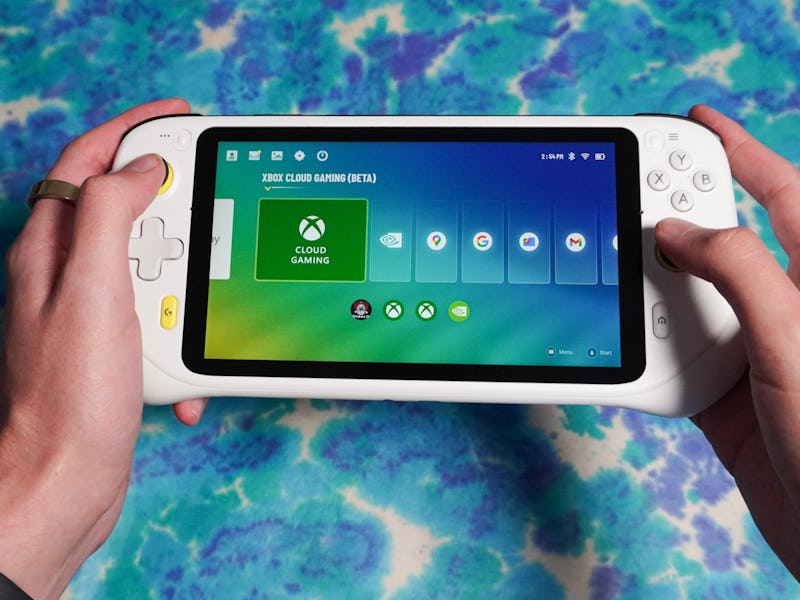Why Microsoft Should Make a Surface-Branded Handheld Gaming PC
With the popularity of the Steam Deck, Microsoft should just make its own Surface version that runs Windows.

Someone at Microsoft sees the potential in the Steam Deck. Employees at the company built a handheld PC interface and other optimizations for supporting devices like the Steam Deck running Windows 11 as part of an internal hackathon, according to a leaked video presentation shared by @_h0x0d_ on Twitter.
The Verge writes that these internal projects are used as a way to convince executives at Microsoft to support new features in upcoming versions of the company’s software. That’s all fine and good; Microsoft has been trending towards more outright controller support for its desktop software as of late, so it might as well make the rest of Windows handheld-friendly. But the company can and could go further — it should make its own handheld PC.
Windows Handheld Mode
Windows needs to be easier to navigate with a controller, and Microsoft employees have some ideas.
The presentation notes a few problems dedicated handheld features for Windows 11 — “Windows Handheld Mode” — would have to address. Those include the obvious, like full software support for controllers and optimizations to the Windows 11 taskbar to make it easier to navigate, and more unexpected ones, like a touch keyboard that works in landscape (the current Windows 11 option is apparently not fully optimized).
The final product demonstrated in the video pulls in other internal Microsoft projects and entirely new software features from this hackathon to create something reminiscent of Valve’s Linux-based SteamOS, that still offers the “full Windows experience.” There’s a bigger taskbar and touch keyboard that play nice with controllers, and a rudimentary launcher for easy access to games and popular PC storefronts like the Xbox app, Steam, and the Epic Games Store.
It looks like the first version of a Microsoft-branded handheld, and according to the members of the hackathon team, it wouldn’t be a huge task to start testing “Windows Handheld Mode” in preview versions of Windows.
Slap the Surface Brand On It
Microsoft suggests the Surface Laptop Studio can be used to play games, but it definitely doesn’t view it as its main purpose.
Until this point, Microsoft has seemed to view handheld hardware as largely an opportunity to push Game Pass and Xbox Cloud Gaming. The closest the company has publicly come to a handheld of its own is consulting with Logitech on the Logitech G Cloud Gaming Handheld and helping to market the device. The G Cloud has its charms, but it gets nowhere near running the number of games that a Steam Deck or Ayaneo handheld can. It’s Android-based and underpowered by design, only meant to access cloud gaming services.
Microsoft has never really tried to focus on PC gaming with its Surface hardware, either. Plenty of people choose Windows because of gaming, but you wouldn’t know that looking at the Surface lineup. The internal specs of Surface devices are modest — the Surface Laptop Studio has an Nvidia graphics card, but it's a 3050 Ti — and most of Microsoft’s effort seems focused on improving the form factor of the modern laptop as opposed to anything else.
But that could be the reason to at least try. The company has the design expertise, and, more importantly, full control over Windows. Not to mention, handhelds are really hot right now. It can make running PC games designed for Windows on a handheld even easier than Valve does if it wants to. It’s not hard to imagine a next-gen Surface Go with controller buttons and joysticks flanking its display. Hell, keep the kickstand! Or make a Backbone-like detachable controller for a Surface Go or Pro. Microsoft could also pivot the Surface Duo from a phone to a Steam Deck-like handheld.
Microsoft wins either way
Of course, it doesn’t need to. Companies like Asus are already making handheld Windows machines like the ROG Ally without explicit support from Microsoft (that either company has publicly claimed, at least). As long as targeting Windows is the main concern of game developers, Microsoft wins. The Proton compatibility layer that’s so key to the Steam Deck’s success is an admission from Valve that no one’s jumping at the opportunity to develop for Linux.
That doesn’t mean Microsoft couldn’t make a difference with a “Surface Deck,” offering a model for the ideal handheld Windows device and spurring even more competition in the space. It just means that as a company trying to make most of its money selling software subscriptions and cloud infrastructure, it doesn’t have to. I’d hope real competition from Sony might change that, but we’ll have to see.